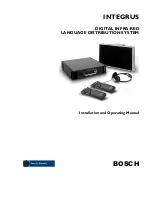
10
| en
INTEGRUS | Digital Infra-red Language Distribution System
BOSCH Security Systems B.V.| February 2003
&
"
Figure 1.6 Polar diagram of the radiation pattern for 1, 2, 4 and 8 carriers
The cross section of the 3-dimensional radiation pattern with the floor of the conference venue is known as the footprint (the
white area in Figure 1.7 to Figure 1.9). This is the floor area in which the direct signal is strong enough to ensure proper
reception, when the receiver is directed towards the radiator. As shown, the size and position of the footprint depends on the
mounting height and angle of the radiator.
Figure 1.7 The radiator mounted at 15
G
to
the ceiling
Figure 1.8 The radiator mounted at 45
G
to
the ceiling
Figure 1.9 The radiator mounted
perpendicular (at 90
G
) to the ceiling
1.3.3 Ambient
lighting
The Integrus system is practically immune for the effect of ambient lighting. Fluorescent lamps (with or without electronic
ballast or dimming facility), such as TL lamps or energy saving lamps give no problems with the Integrus system. Also sunlight
and artificial lighting with incandescent or halogen lamps up to 1000 lux give no problems with the Integrus system.
When high levels of artificial lighting with incandescent or halogen lamps, such as spotlights or stage lighting are applied, you
should directly point a radiator at the receivers in order to ensure reliable transmission.
For venues containing large, unscreened windows, you must plan on using additional radiators.
For events taking place in the open air a site test will be required in order to determine the required amount of radiators. With
sufficient radiators installed, the receivers will work without errors, even in bright sunlight.
1.3.4 Objects, surfaces and reflections
The presence of objects in a conference venue can influence the distribution of infra-red light. The texture and colour of the
objects, walls and ceilings also plays an important role.
Infra-red radiation is reflected from almost all surfaces. As is the case with visible light, smooth, bright or shiny surfaces reflect
well. Dark or rough surfaces absorb large proportions of the infra-red signal (see Figure 1.10). With few exceptions it cannot
pass through materials that are opaque to visible light.

























